Themed collection Collection to celebrate our diverse and global authorship

Chromium complexes for luminescence, solar cells, photoredox catalysis, upconversion, and phototriggered NO release
Cr(III) and Cr(0) complexes are earth-abundant alternatives to photosensitizers that are commonly made from precious metals.
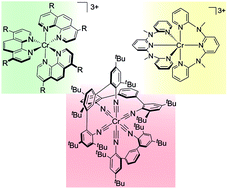
Chem. Sci., 2017,8, 7359-7367
https://doi.org/10.1039/C7SC03372A
Inedible saccharides: a platform for CO2 capturing
Renewable materials, viz. cellulose, chitin, chitosan and cyclodextrins are promising alternatives to petroleum-based feedstocks for CO2 sequestration.
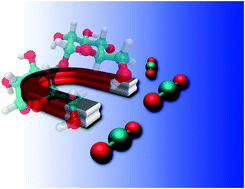
Chem. Sci., 2018,9, 1088-1100
https://doi.org/10.1039/C7SC04706A
Highly luminescent phosphine oxide-containing bipolar alkynylgold(III) complexes for solution-processable organic light-emitting devices with small efficiency roll-offs
Phosphine oxide-containing alkynylgold(III) complexes were synthesized and fabricated into solution-processable OLEDs with high EQEs and small efficiency roll-offs.
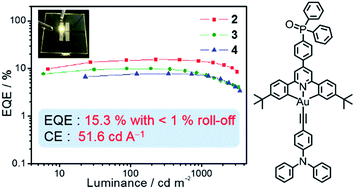
Chem. Sci., 2018,9, 6228-6232
https://doi.org/10.1039/C8SC02265H
Consequences of a cosolvent on the structure and molecular dynamics of supramolecular polymers in water
A cosolvent that is used to guide the self-assembly of amphiphiles in water causes abrupt structural changes, as well as non-linear behavior in the molecular dynamics of the amphiphiles.
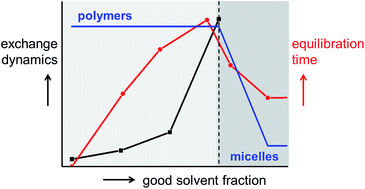
Chem. Sci., 2018,9, 6199-6209
https://doi.org/10.1039/C8SC02257G
Tris(benzoimidazol)amine (L) complexes of pnictogen(III) and pnictogen(V) cations and assessment of the [LP]3+/[LPF2]3+ redox couple
A tris((1-ethyl-benzoimidazol-2-yl)methyl)amine (BIMEt3) complex of P3+ is oxidized with XeF2 to access [PF2(BIMEt3)]3+ representing the first structurally characterized example of a phosphorus(V)3+ cation.
![Graphical abstract: Tris(benzoimidazol)amine (L) complexes of pnictogen(iii) and pnictogen(v) cations and assessment of the [LP]3+/[LPF2]3+ redox couple](/en/Image/Get?imageInfo.ImageType=GA&imageInfo.ImageIdentifier.ManuscriptID=C8SC01682H&imageInfo.ImageIdentifier.Year=2018)
Chem. Sci., 2018,9, 5837-5841
https://doi.org/10.1039/C8SC01682H
White-light emission from a single organic compound with unique self-folded conformation and multistimuli responsiveness
White-light emission from a single molecule was realized and tuned via multistimuli including excitation, solvent polarity, temperature and host–guest interactions.
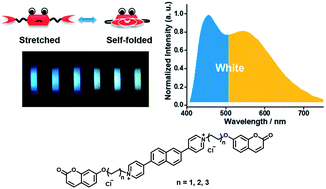
Chem. Sci., 2018,9, 5709-5715
https://doi.org/10.1039/C8SC01915K
Revealing the unusual role of bases in activation/deactivation of catalytic systems: O–NHC coupling in M/NHC catalysis
Usual oxygen bases decompose M/NHC complexes to give “NHC-free” metal species and azolones.

Chem. Sci., 2018,9, 5564-5577
https://doi.org/10.1039/C8SC01353E
Rapid photoinduced charge injection into covalent polyoxometalate–bodipy conjugates
A series of redox tunable polyoxometalate–bodipy conjugates display variable charge transfer dynamics occuring down to 54 ps.

Chem. Sci., 2018,9, 5578-5584
https://doi.org/10.1039/C8SC00862K
Pyrene hydrogel for promoting direct bioelectrochemistry: ATP-independent electroenzymatic reduction of N2
We demonstrate a novel hydrogel material to facilitate direct bioelectrochemistry of a wide range of redox proteins and enable ATP-independent electroenzymatic reduction of N2 by nitrogenase.
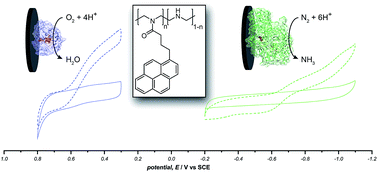
Chem. Sci., 2018,9, 5172-5177
https://doi.org/10.1039/C8SC01638K
A high spatiotemporal study of somatic exocytosis with scanning electrochemical microscopy and nanoITIES electrodes
Extra-synaptic exocytosis is an essential component of cellular communication. A knowledge gap exists in the exocytosis of the non-redox active transmitter acetylcholine. Using the nano-interface between two immiscible electrolyte solutions and scanning electrochemical microscopy, a high resolution spatiotemporal study of acetylcholine exocytosis is shown from individual neuronal soma.
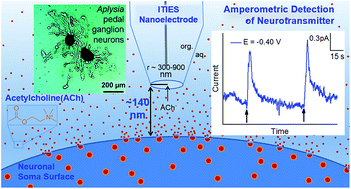
Chem. Sci., 2018,9, 4937-4941
https://doi.org/10.1039/C8SC01131A
The chemical identity, state and structure of catalytically active centers during the electrochemical CO2 reduction on porous Fe–nitrogen–carbon (Fe–N–C) materials
We report novel structure–activity relationships and explore the chemical state and structure of catalytically active sites under operando conditions during the electrochemical CO2 reduction reaction (CO2RR) catalyzed by a series of porous iron–nitrogen–carbon (FeNC) catalysts.
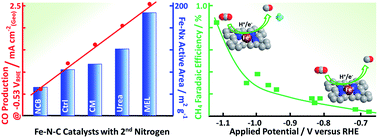
Chem. Sci., 2018,9, 5064-5073
https://doi.org/10.1039/C8SC00491A
Stapled peptides as a new technology to investigate protein–protein interactions in human platelets
We describe the first application of stapled peptides in human platelets. Bim BH3 stapled peptides are used to overcome the limitations of traditional methods and uncover a new role for Bim in platelet activation.
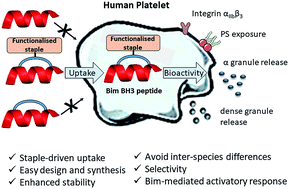
Chem. Sci., 2018,9, 4638-4643
https://doi.org/10.1039/C8SC00284C
Acidity and basicity interplay in amide and imide self-association
Simple acid–base properties explain the differences in amide and imide dimerisation, and represent an alternative to the secondary interactions hypothesis.
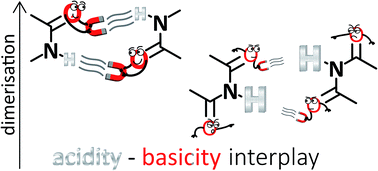
Chem. Sci., 2018,9, 4402-4413
https://doi.org/10.1039/C8SC01020J
Taming a monomeric [Cu(η6-C6H6)]+ complex with silylene
Realization of a hitherto elusive unsupported η6 binding mode of benzene to a copper(I) cation employing silylene as a ligand. The back-donation from Cu to Si(II) diminishes the repulsion between d-electrons and the benzene ring and enforces the η6 binding mode.
![Graphical abstract: Taming a monomeric [Cu(η6-C6H6)]+ complex with silylene](/en/Image/Get?imageInfo.ImageType=GA&imageInfo.ImageIdentifier.ManuscriptID=C8SC00459E&imageInfo.ImageIdentifier.Year=2018)
Chem. Sci., 2018,9, 4333-4337
https://doi.org/10.1039/C8SC00459E
Protein surface functionalisation as a general strategy for facilitating biomimetic mineralisation of ZIF-8
The surface charge and chemistry of a protein determines its ability to facilitate biomimetic mineralisation.

Chem. Sci., 2018,9, 4217-4223
https://doi.org/10.1039/C8SC00825F
Unusual mechanisms in Claisen rearrangements: an ionic fragmentation leading to a meta-selective rearrangement
A mechanistic investigation of the acid-catalysed redox-neutral arylation of ynamides intertwining ESI-MS, DFT and experiments reveals diverse pathways available from an otherwise simple-looking transformation.
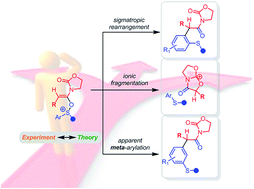
Chem. Sci., 2018,9, 4124-4131
https://doi.org/10.1039/C7SC04736C
C–H activation and nucleophilic substitution in a photochemically generated high valent iron complex
The (photo) chemical oxidation of a (TAML)FeIII complex using outer-sphere oxidants results in valence tautomerisation and C–H activation governed by exogenous anions.
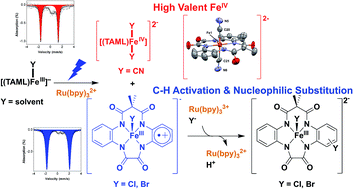
Chem. Sci., 2018,9, 3992-4002
https://doi.org/10.1039/C7SC05378A
Covalent triazine framework modified with coordinatively-unsaturated Co or Ni atoms for CO2 electrochemical reduction
Nickel-modified covalent triazine frameworks effectively reduced CO2 to CO because adsorbed COOH was stabilized on the coordinatively-unsaturated Ni atoms in CTF.

Chem. Sci., 2018,9, 3941-3947
https://doi.org/10.1039/C8SC00604K
Disentanglement of excited-state dynamics with implications for FRET measurements: two-dimensional electronic spectroscopy of a BODIPY-functionalized cavitand
Two-dimensional electronic spectroscopy of energy transfer and competing dynamics highlights how conformational changes create issues with lifetime-based FRET measurements.
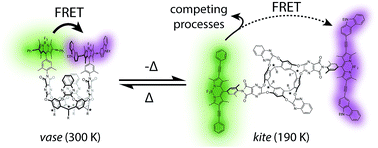
Chem. Sci., 2018,9, 3694-3703
https://doi.org/10.1039/C8SC00818C
Sequential electron transfer governs the UV-induced self-repair of DNA photolesions
QM/MM simulations elucidate the self-repair mechanism of the cyclobutane pyrimidine dimer.
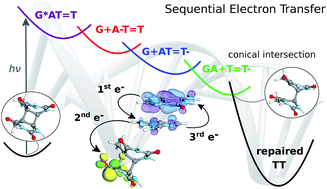
Chem. Sci., 2018,9, 3131-3140
https://doi.org/10.1039/C8SC00024G
Label-free and live cell imaging by interferometric scattering microscopy
Despite recent remarkable advances in microscopic techniques, it still remains very challenging to directly observe the complex structure of cytoplasmic organelles in live cells without a fluorescent label.
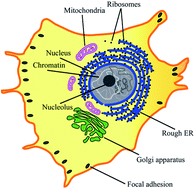
Chem. Sci., 2018,9, 2690-2697
https://doi.org/10.1039/C7SC04733A
Understanding light-driven H2 evolution through the electronic tuning of aminopyridine cobalt complexes
Electronic effects provide a general mechanistic scenario for rationalizing photocatalytic water reduction activity with aminopyridine cobalt complexes.
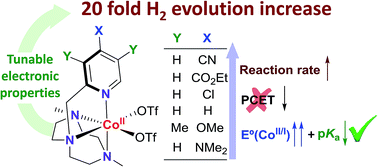
Chem. Sci., 2018,9, 2609-2619
https://doi.org/10.1039/C7SC04328G
Total chemical synthesis of glycocin F and analogues: S-glycosylation confers improved antimicrobial activity
Replacing the O-linked saccharide in the bacteriocin glycocin F with an S-linked version results in a peptidomimetic that increases the bacteriostatic effect.
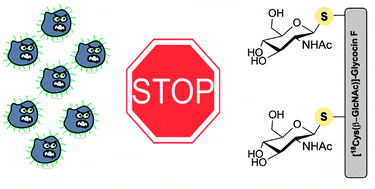
Chem. Sci., 2018,9, 1686-1691
https://doi.org/10.1039/C7SC04383J
Total chemical synthesis of ester-linked ubiquitinated proteins unravels their behavior with deubiquitinases
The novel synthetic strategy for preparation of ester linked ubiquitinated proteins was developed. We found that the ester linkage could be cleaved by deubiquitinases with different efficiency relative to the isopeptide-linked substrate.
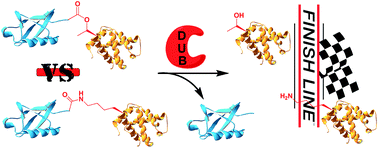
Chem. Sci., 2018,9, 1661-1665
https://doi.org/10.1039/C7SC04518B
The mechanism of a green fluorescent protein proton shuttle unveiled in the time-resolved frequency domain by excited state ab initio dynamics
A new time-resolved vibrational analysis unveils the mechanism of an excited state proton shuttle in green fluorescent protein.
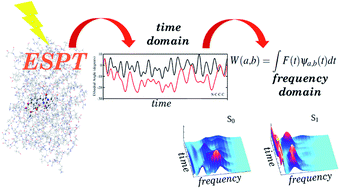
Chem. Sci., 2018,9, 1126-1135
https://doi.org/10.1039/C7SC02803B
High-affinity and selective detection of pyrophosphate in water by a resorcinarene salt receptor
N-Alkyl ammonium resorcinarenes selectively bind pyrophosphate in pure water with an exceptionally high binding constant of up to 1.60 × 107 M−1, three orders of magnitude higher than ATP.
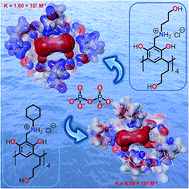
Chem. Sci., 2018,9, 1358-1367
https://doi.org/10.1039/C7SC05167K
Enantiomeric resolution and X-ray optical activity of a tricobalt extended metal atom chain
Enantiopure single crystals of extended metal atom chains display exceptionally large optical X-ray dichroisms at the Co K-edge.
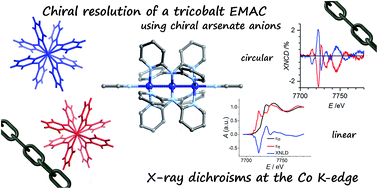
Chem. Sci., 2018,9, 1136-1143
https://doi.org/10.1039/C7SC04131D
A three-in-one-bullet for oesophageal cancer: replication fork collapse, spindle attachment failure and enhanced radiosensitivity generated by a ruthenium(II) metallo-intercalator
[Ru(phen)2(tpphz)]2+ simultaneously inhibits DNA replication, blocks mitosis and enhances DNA-damaging ionising radiation in oesophageal cancer cells.

Chem. Sci., 2018,9, 841-849
https://doi.org/10.1039/C7SC03712K
Epimerization-free access to C-terminal cysteine peptide acids, carboxamides, secondary amides, and esters via complimentary strategies
We present a convenient method for the diversification of peptides bearing cysteine at the C-terminus that proceeds to form a variety of carboxylic acid, carboxamide, 2° amide, and ester terminated peptides without any detectable epimerization of the α-stereocenter.

Chem. Sci., 2018,9, 350-355
https://doi.org/10.1039/C7SC03553E
Selective electrochemical generation of benzylic radicals enabled by ferrocene-based electron-transfer mediators
The use of ferrocene mediators offers significant advantages over direct electrolysis in the generation and functionalization of radicals from benzylboronates.
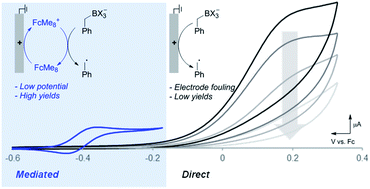
Chem. Sci., 2018,9, 356-361
https://doi.org/10.1039/C7SC04032F
Understanding the origins of metal–organic framework/polymer compatibility
The microscopic interfacial structures for a series of metal–organic frameworks (MOFs)/polymer composites consisting of the Zr-based UiO-66 coupled with different polymers are systematically explored by applying a computational methodology that integrates density functional theory calculations and force field-based molecular dynamics simulations.

Chem. Sci., 2018,9, 315-324
https://doi.org/10.1039/C7SC04152G
Unveiling hole trapping and surface dynamics of NiO nanoparticles
Mesoporous NiO is used as p-type material in photoelectrochemical energy conversion devices. The presence of two kinds of hole traps can affect device performance. Here, after band-gap excitation, the relaxation of the hole into two different traps was observed and characterized.
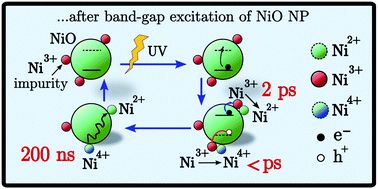
Chem. Sci., 2018,9, 223-230
https://doi.org/10.1039/C7SC03442C
Achieving nano-gold stability through rational design
Au nanoparticles isolated on the tips of a thermally stable, radially aligned nano-structure providing a highly sinter-resistant catalyst.
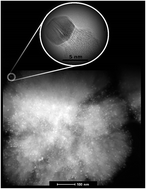
Chem. Sci., 2016,7, 6815-6823
https://doi.org/10.1039/C6SC01597B
About this collection
This collection of Chemical Science articles has been put together by our Editorial team to celebrate our diverse and global community. Including high quality articles from corresponding authors from six different continents, this collection reflects, in a small way, the truly international nature of the content that we publish in Chemical Science.